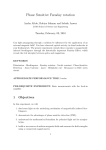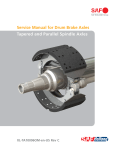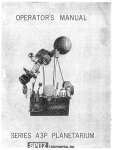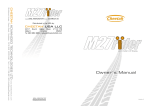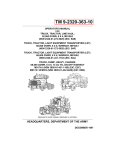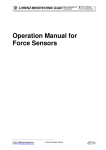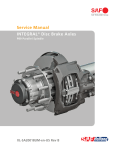Download Brittain Navigation Coupler Operation and Service
Transcript
MOONEY NAVIGATION COUPLER OPERATION & SERVICE INSTRUCTIONS MANUAL No. 11990-1 BRITTAIN INDUSTRIES, INC. TULSA, OKLAHOMA Issue A 5/31/01 . TABLE OF CONTENTS Title PARAGRAPH PAGE 1 1 1.3 1.4 1 3 Navigation Radio Requirements 2 4 Survey of Autopilot Installation 3 6 3.1 3.2 3.3 7 7 7 4 8 Heading Gain Adjustment VOR Gain Adjustment Magnetic Heading Compensation Heading Dial Adjustment 4.4 4.6 4.8 4.9 8 10 10 13 Operational Flight Check & Adjustments 5 13 5.1 5.2 5.3 5.4 13 13 14 14 Emergency Procedures 6 15 Returning Aircraft to Service 7 15 Location of Field Adjustments - 16 Zone Chart - 17 Theory of Operation Magnetic Heading Control Radio Navigation Coupling Airframe Requirements Electrical System Requirements Radio Navigation Coupling Pre-Flight Adjustments Pre-Flight Checks Functional Operation Rate of Turn Directional Control INTRODUCTION The purpose of this manual is to assist service and maintenance personnel in testing and calibration of the Nav-Coupler/Heading Lock System. This manual is concerned primarily with the Nav-Coupler/Heading Lock System. It is imperative that the "Positive Control" System is functioning properly before the ground and flight test procedures outlined in this manual are completed. This manual was automated on May 31, 2001. Changes were made only to correct typographical errors and to clarify content. 11990-1 Page 1 1. THEORY OF OPERATION 1.1 In the Nav-Coupler/Heading Lock System, the directional control of the aircraft is obtained by means of an electro-pneumatic servo valve. This servo provides vacuum to command aileron and rudder control. Variations in the voltage operating the servo valve are produced in the Controller/Amplifier Assembly. This is accomplished by means of Sensor and Radio Navigation equipment. In addition, a Heading Select Knob, located on the Controller Amplifier operates the Servo Valve for maneuvering of the aircraft. 1.2 Rate of turn depends upon proper basic system operation. For this reason, it is essential that the roll/yaw stabilizing system be correctly adjusted. Refer to Operation and Service Manual 11990 to verify proper operation of the basic system. 1.3 Magnetic Heading Control Magnetic heading information is obtained by means of a Magnetic Heading Sensor. When the heading azimuth on the controller is set to 90° and the aircraft is on a heading of 90°, the electrical circuit is balanced. When the controller heading azimuth is rotated to 180°, electrical imbalance is generated. This imbalance produces an error signal that is amplified in the amplifier section. The amplified signal generates voltage on the right side of the Servo Valve, causing it to open. With the valve open, the aircraft turns right until the error signal is removed by the Heading Sensor. When the aircraft assumes a heading of 180°, the Magnetic Sensor and the heading azimuth are in phase and the voltage at the servo valve drops to zero. When the heading azimuth and the electrical output of the magnetic sensor are in phase, any change in the heading of the aircraft to right or left will produce an error signal from the sensor. This signal will cause the valve to be rotated to the right or left to bring the aircraft back to the point where no error is generated at the sensor. 11990-1 Page 2 1. THEORY OF OPERATION (CONTINUED) 1.3 Magnetic Heading Control (Continued) The magnetic heading sensor is remotely mounted in the aircraft similar to a remote indicating compass. The sensor has no moving parts and requires no servicing. The sensor installation is designed to permit the unit to move freely as a pendulum on the longitudinal axis of the aircraft. Acceleration and deceleration of the aircraft displaces the sensor on its pivots and may produce momentary changes in magnetic headings on East and West. Improper dressing of the sensor harness, causing a restriction of the pendulous motion, will exaggerate this heading error. There is a definite relationship between the rate of turn and programmed magnetic headings. The circuitry providing magnetic heading information is designed for "roll out" characteristics that assume a given rate of turn. If this rate is greater than 3° per second, there will be a tendency for the aircraft to over-shoot programmed magnetic turns to East, North and West. Proper rate of turn should allow for approximately 5° over-shoot on East and West, with less than 5° over-shoot on North and South. Unequal turns to left and right may be caused by improper rigging of the aircraft. If an aircraft is rigged to fly with one wing down, or with the ball of the Turn Coordinator off center, turns will be steeper in one direction than the other. Proper rigging may be determined only when the Positive Control System is shut off. In all magnetic airborne devices, there are certain inherent errors caused by the vertical component of the earth's magnetic field. To minimize the undesirable effect of the vertical component, there are compensating transistorized networks in the system. The amount of compensation produced may be varied by positioning the "zone selector" on the Controller/ Amplifier Assembly. Make certain that the zone switch is set to correspond with the positions indicated on the map showing the selector zones (See Diagram II). 11990-1 Page 3 1. THEORY OF OPERATION (CONTINUED) 1.4 Radio Navigation Coupling Radio VOR coupling is obtained by means of additional circuits in the amplifier. These circuits are connected to the VOR meter output of the navigational equipment. When the VOR deviation is to the right (in yellow zone), the electro-pneumatic servo valve is rotated to the right, commanding a right turn. When the VOR deviation is to the left (in the blue zone), a left turn is commanded. The voltage generated in the VOR system also modulates the Nav-Coupler. Omni heading intercept and hold is accomplished by selecting the desired VOR radial with the OBS selector of the navigational equipment. The Omni radial is matched by selecting the same heading on the rotatable heading azimuth. When the aircraft is not on the selected VOR radial, the VOR meter will be displaced from the center position. This displacement represents a bi-polar meter voltage, causing the servo valve to open until the voltage is zero. When the meter voltage becomes zero, the aircraft will continue to fly on the magnetic heading selected on the heading azimuth. . The relationship of heading to navigation information varies in the Capture and Track modes. In the Capture mode, a full scale VOR meter deviation will produce a heading change as great as 45° from a selected magnetic heading. As the desired VOR radial is approached, meter displacement decreases and the aircraft will gradually turn toward the selected magnetic heading. In the Capture position, a VOR error signal equal to 1° off course will cause a change in selected heading of 5°. Maximum bank angle in the Capture mode is a standard rate turn. The system is more sensitive to the VOR meter displacement in the Track mode. This optimizes the tracking of a captured omni radial. The bank angle in the Track mode is one-third of the maximum bank angle obtained in the Capture mode. 11990-1 Page 4 1. THEORY OF OPERATION (CONTINUED) 1.4 Radio Navigation Coupling (Continued) Added circuitry in the Track mode optimizes station crossing where the navigation signal shifts phase. The Track mode effectiveness of the VOR signal is limited to a maximum of 5° displacement. When the VOR needle exceeds 5° off course, magnetic heading data supersedes radio navigation information, precluding rapid and excessive heading excursions over a VOR station. 2. NAVIGATIONAL RADIO REQUIREMENTS FOR AUTOPILOT COUPLING 2.1 The Autopilot is designed to accept an impedance load of 10,000 ohms. The intercept circuitry of the Nav-Coupler is floating with respect to ground. Optimum Autopilot response is obtained with as little as 35 millivolts across the VOR meter circuit for 10° off course. (Bi-polar voltage up to 150 millivolts is acceptable and may be attenuated by the amplifier nav sens adjustment.) By reason of these characteristics, the Nav-Coupler is compatible with most navigation radio equipment. 2.2 There are considerable differences in the electrical characteristics of radio navigation equipment of various models and makes. They are divided into two categories: ARINC Standard and non-ARINC Standard equipment. A. Radio navigation equipment meeting ARINC Standards has provisions for three or more 1,000 ohm loads. Autopilot coupling may be connected across the VOR meter output without changing existing loads. All ARINC Standard equipment will provide adequate signal levels for optimum Autopilot Nav-Coupler operation 11990-1 Page 5 2. NAVIGATIONAL RADIO REQUIREMENTS FOR AUTOPILOT COUPLING (CONT'D) 2.2 (Continued) B. Radio navigation equipment not designed to ARINC Standards may be used, in most instances, with the Autopilot Coupler system. Some of the equipment in this category requires no circuit modification to connect the Nav-Coupler to the VOR meter. There is considerable radio navigational equipment that does not provide sufficient signal output for operating the Autopilot Coupler. Prior to ground check procedure, determine whether the existing radio equipment is compatible with the Nav-Coupler. Determine if a bi-polar voltage across the VOR meter of 35 millivolts minimum for 10° off course, is present. Radio equipment compatibility in this group is also. determined by a ground check procedure wherein navigation error information is balanced against magnetic heading information. If there is any question regarding the respective radio compatibility, the information in 2.1 should be transmitted to the appropriate radio equipment manufacturer for recommendations. 2.3 Some VOR units have a floating ground in the indicator circuit. Coupling to the Autopilot (also floating with respect to ground) may result in overloading of the Autopilot amplifier circuits. Loading may result in an offset of the servo valve in the amplifier shown by a voltage differential across the yellow and orange test jacks when the VOR equipment is energized. Loading of the amplifier may be corrected by placing a ground connection or jumper between lead #3 of the cable assembly and the chassis of the VOR converter. 11990-1 Page 6 2. NAVIGATIONAL RADIO REQUIREMENTS FOR AUTOPILOT COUPLING (CONT’D) 2.4 The Autopilot Nav-Coupler is capable of responding to minute deviations of the VOR indicator. This sensitivity level is necessary to obtain optimum Omni capture and track performance. Make certain the radio navigation equipment is functioning properly, and that the VOR needle is steady. The use of an Omni Simulator or Omni Station capable of producing a full scale meter deflection is recommended. With needle centered, check for erratic needle movement. This must be at a minimum. Check generator and voltage regulator. Make certain they are sufficiently filtered to minimize electrical interference. Check Omni course width and sensitivity to equipment manufacturer's specifications. NOTE: 3. The Autopilot equipment must respond to the electrical information appearing on the VOR meter. If this information is inaccurate, undesirable Autopilot coupling will result. 2.5 Verify that the aircraft's voltage regulator is producing the proper voltage. This check should be made with a maximum electrical load applied and a fully charged battery. (Low voltage will result in sub-standard operation and a decreased rate of turn.) After installation of the Nav-Coupler, it must be determined that the operation of the radio navigation equipment meets the radio manufacturer's minimum performance specifications, using specifications and procedures specified in the radio manufacturer's service and maintenance manual. 2.6 Wires #3 and #4 from the controller harness are to be connected in parallel to the left/right meter movement of the VOR/LOC Indicator. An optional double-pole double-throw switch may be installed to enable the pilot to switch the Nav-Coupler from the #1 VOR to #2 VOR if desired. The output from the two Omni converters must be equal or mismatching will occur. SURVEY OF AUTOPILOT INSTALLATION & BASIC REQUIREMENTS The purpose of this section is to furnish a procedure for verifying proper installation and function of the Autopilot components and system. 11990-1 Page 7 3. SURVEY OF AUTOPILOT INSTALLATION & BASIC REQUIREMENTS (CONT’D) 3.1 Airframe Requirements Prior to installing the flight control equipment, the aircraft should be flown to determine whether the basic "Positive Control" system is properly operating. Refer to manual 11990 for proper operation of the basic system. The following items must be verified for proper operation before proceeding with the ground adjustment procedures: A. B. C. D. 3.2 Primary vacuum setting Cut-off valve operation Pilot valve operation Proper airframe rigging Electrical System Requirements The sensor should be installed in an area that is free of magnetic fields. Proximity to a power supply, remote indicating compass, etc., may result in magnetic variations which cannot be compensated. Such interference, although uncommon, may result from locating the sensor in the proximity of a VHF antenna. Lead #1 is system ground, make certain this lead is not connected with any other ground lead. 3.3 Radio Navigation Coupling Determine the compatibility of the navigational radio equipment according to the radio compatibility chart, found in the installation manual. Temporarily connect leads #3 and #4 of the cable assembly to the VOR indicator until proper left/right phasing has been determined. Refer to the installation manual for proper pin connections. 11990-1 Page 8 4. PRE-FLIGHT ADJUSTMENTS Use the following ground-test procedure to determine that the electrical and vacuum portions of the equipment are functioning properly before flight testing is attempted. 4.1 To perform the ground-test adjustments, it is necessary to partially remove the Controller/Amplifier from the instrument panel. Turn the latching screw counter clockwise until the latch is disengaged. Diagram I shows the location of the latching screw and the controls to be adjusted during ground-test. 4.2 Pull the Controller/Amplifier approximately one-half way out of the instrument panel for access to the controls. Connect a 10,000 Ohm per volt voltmeter to the orange and yellow test jacks located in the lower right front corner of the Controller/Amplifier. Set the voltmeter to the 10 or 12 volt D.C. range. CAUTION The hemisphere switch should be set to the intermediate "T" (test) position and the zone switch should be set to the proper zone number. 4.3 The following adjustments are to be made with the aircraft on the compass rose. Have the aircraft running with all electrical equipment turned on. 4.4 Heading Gain Adjustment Adjust the HDG dial to the aircraft heading, as indicated by zero volts on the D.C. voltmeter. Turn the HDG dial to a heading of + 30° from the previously determined heading. From the-map shown on Diagram II, determine the position of the aircraft within its zone. Adjust the HDG gain control shown in Diagram I until the voltmeter reading corresponds to that shown in Figures 1 & 2 for the appropriate aircraft location within the zone. 11990-1 Page 9 4. PRE-FLIGHT ADJUSTMENTS (CONTINUED) 4.5 Heading Gain Adjustment (Continued) AIRCRAFT POSITION WITHIN MAGNETIC ZONE OUTPUT VOLTAGE FOR ± 30 HEADING ERROR Southern Boundary 6.8 Volts Southern Quarter 6.4 Volts Center 6.0 Volts Northern Quarter 5.7 Volts FIGURE NO. 1 FIGURE NO. 2 11990-1 Page 10 4. FLIGHT ADJUSTMENTS (CONTINUED) 4.6 VOR Gain Adjustment Make certain that the VOR Receiver and Converter-Indicator are operating properly and meet the manufacturer's specifications. The performance of the navigation coupler is dependent upon the quality of the signal from the VOR Converter. 4.7 Use a VOR simulator or a very strong, steady station signal. Connect the D.C. voltmeter to the test jacks. Place the mode selector switch in the "HDG" position. Set the OBS on the VOR Indicator to a 5° bearing error. Set the "HDG" dial to the aircraft heading, as indicated by zero output on the voltmeter. Turn the mode switch to the "CAP" position. Adjust the nav pot until a reading of 5 volts is obtained on the voltmeter. NOTE: 4.8 It is necessary to adjust the gain control and heading dial slowly in order to obtain accurate settings. Magnetic Heading Compensation To compensate the Magnetic Heading Sensor the same technique is used as in compensating the primary aircraft compass. Rotation of the E-W adjustment clockwise or counter-clockwise will bend East and West headings both towards North or South. Example: 11990-1 Page 11 4. PRE-FLIGHT ADJUSTMENTS (CONTINUED) 4.8 Magnetic Heading Compensation (Continued) Rotation of the N-S adjustment clockwise or counterclockwise will bend both North and South towards East or West. Example: Example #1: A reading of 085° east and 275° West would necessitate rotating the E-W adjustment to bend both East and West 5° towards South, bringing west to 270° and East to 090°. Example #2: North is 355° and south is 185°. Rotate the N-S adjustment to bend both North and South towards East 5°, bringing north to 0° and South to 180°. Adjustments for magnetic heading should be made according to the following sequence. A. Use a compass rose or a master compass. Align aircraft on North. Set function switch to "HDG" and the hemisphere switch on "T". Connect a voltmeter to the test jacks shown in Diagram I. B. Rotate heading azimuth card to obtain "0" volts on the voltmeter, make certain heading card is approximately on 0° and not 180°. The following readings should be noted and recorded on Figure 3A: The reading from the azimuth card, the ship's compass, and the directional gyro. 11990-1 Page 12 4. PRE-FLIGHT ADJUSTMENTS (CONTINUED) 4.8 Magnetic Heading Compensation (Continued) B. Continued Set directional gyro to "0" and uncage. Turn aircraft to 090° on directional gyro. Rotate azimuth card on heading lock to approximately 090° to obtain "0" volts on voltmeter. Record the heading shown on azimuth card in Figure 3A, also, the reading of the ship's compass. Proceed in exactly the same manner with South and West headings. After all the readings have been recorded, draw an azimuth as per Figure 3, and record the actual error in the headings. C. From Figure 3 (plotted in Figure 3A) you can see exactly what has to be done. In this case, you would bend North and South to read, North + 4° and South + 3°. Bend East and West 4°, making West + 3° and East + 4°. From this we now have + 4° on North, + 4° on East, + 3° on South and + 3° on West (dotted line). The headings are all high and the next adjustment would be accomplished on the Controller as follows. 11990-1 Page 13 4. PRE-FLIGHT ADJUSTMENTS (CONTINUED) 4.9 "HDG" Dial Adjustment If all readings are high or low, loosen the setscrew securing the "HDG" dial to the resolver shaft and rotate it slightly to bring selected headings into alignment with actual headings. 5. OPERATIONAL FLIGHT CHECK AND ADJUSTMENTS 5.1 Pre-Flight Checks Review the ground check inspection record and make certain that all items have been covered. Place the hemisphere selector switch in the appropriate position. (i.e., "N" for Northern hemisphere- "S" for Southern hemisphere) Complete the aircraft logs for the installation and have the appropriately rated pilot, who is to flight test the installation, familiarize themselves with the "Owner's Operating Manual". While taxiing the aircraft, observe the aircraft as it is turned to the right. The control wheel will rotate to the left and vice-versa. This verifies proper output and phasing of the gyro in the roll/yaw system. With the engine running and nose wheel straight forward, select "HDG" mode and command right and left turns by rotating the "HDG" knob. Rotate the heading azimuth to correspond with the aircraft's heading and select the "CAP" mode. Verify that VOR needle deflection to the right and left commands right and left turns respectively. 5.2 Functional Operation Climb to a safe altitude above the terrain. Attempt to find smooth air in which to conduct flight test. Trim the airplane for straight and level flight at cruise configuration. If a malfunction should occur in any of the flight control units, the system can be overpowered with pressure on the manual controls. The entire Autopilot may be disengaged by depressing the Cut Off valve in the control wheel. 11990-1 Page 14 5. OPERATIONAL FLIGHT CHECK AND ADJUSTMENTS (CONTINUED) 5.3 Rate of Turn With the aircraft laterally trimmed in level flight, and at constant cruising speed, select the "HDG" mode. Command a 90° turn to the left by rotating the heading azimuth. Note the aircraft turn rate which should be at a standard rate or slightly less. Repeat this procedure to the right. If the turns are asymmetrical by more than 1/8 standard rate, refer to the basic system Operation and Service manual for corrective procedures. Particular attention should be paid to system leak check and aircraft rigging instructions. 5.4 Directional Control Place the mode function knob in the "HDG" position and the latitude selector in the appropriate zone specified in Diagram II. Program turns by rotating the heading azimuth. There is a definite relationship between the rate of turn and programmed magnetic headings. The circuitry providing magnetic heading information is designed for "roll out" characteristics that pre-suppose a given rate of turn. If the rate of turn is greater than 3° per second, there will be a tendency for the aircraft to over-shoot programmed magnetic turns to the East, North and West. If too shallow of a turn is produced, programmed magnetic turns to the North will be slow in approaching the final heading and nearly exact on east and west. Turns to the South with a shallow bank angle may over-shoot the final southerly programmed heading. Proper rate of turn allows for approximately 5° over-shoot on East and West, with less than 5° over-shoot on North and South. Proper rigging of the aircraft is essential for precise headings. If an aircraft is rigged to fly with one wing down, or with the ball of the Turn Coordinator off center, turns will be steeper in one direction than the other. 11990-1 Page 15 5. OPERATIONAL FLIGHT CHECK AND ADJUSTMENTS (CONTINUED) 5.4 Directional Control (Continued) When evaluating the accuracy of the magnetic headings, remember that reference to a directional gyro should take into consideration precessional errors. Reference to the aircraft's magnetic compass must allow for compass errors. Check the radio navigation coupler. If an airborne VOR test signal is available, verify the adjustment of the NAV-SENS. This is readily accomplished by allowing the aircraft to stabilize on a random magnetic heading. Center the VOR needle and dial 5° OBS off course, place the mode function knob on "CAP" and observe on the directional gyro the number of degrees of turn that have been commanded by the 5° VOR needle displacement. (5° Omni error should produce from 23° to 26° heading change.) Observe the VOR needle to make certain that there are no erratic movements. (If erratic needle action is noticed, check the Omni converter and navigation receiver for intermittent operation.) 6. EMERGENCY PROCEDURES If a malfunction should occur in any of the flight control units, the system can be overpowered merely with pressure on the manual controls. The entire Autopilot may be disengaged by depressing the Cut-Off Valve on the control head. 7. RETURNING AIRCRAFT TO SERVICE Upon completing the flight test, entry should be made in the aircraft log that the Autopilot system has been test flown and evaluated for proper function by an appropriately rated pilot. (REF: FAR part 91.167 A.) 11990-1 Page 16 11990-1 Page 17




















